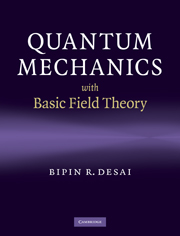Book contents
- Frontmatter
- Contents
- Preface
- Physical constants
- 1 Basic formalism
- 2 Fundamental commutator and time evolution of state vectors and operators
- 3 Dynamical equations
- 4 Free particles
- 5 Particles with spin ½
- 6 Gauge invariance, angular momentum, and spin
- 7 Stern–Gerlach experiments
- 8 Some exactly solvable bound-state problems
- 9 Harmonic oscillator
- 10 Coherent states
- 11 Two-dimensional isotropic harmonic oscillator
- 12 Landau levels and quantum Hall effect
- 13 Two-level problems
- 14 Spin ½ systems in the presence of magnetic fields
- 15 Oscillation and regeneration in neutrinos and neutral K-mesons as two-level systems
- 16 Time-independent perturbation for bound states
- 17 Time-dependent perturbation
- 18 Interaction of charged particles and radiation in perturbation theory
- 19 Scattering in one dimension
- 20 Scattering in three dimensions – a formal theory
- 21 Partial wave amplitudes and phase shifts
- 22 Analytic structure of the S-matrix
- 23 Poles of the Green's function and composite systems
- 24 Approximation methods for bound states and scattering
- 25 Lagrangian method and Feynman path integrals
- 26 Rotations and angular momentum
- 27 Symmetry in quantum mechanics and symmetry groups
- 28 Addition of angular momenta
- 29 Irreducible tensors and Wigner–Eckart theorem
- 30 Entangled states
- 31 Special theory of relativity: Klein–Gordon and Maxwell's equations
- 32 Klein–Gordon and Maxwell's equations
- 33 The Dirac equation
- 34 Dirac equation in the presence of spherically symmetric potentials
- 35 Dirac equation in a relativistically invariant form
- 36 Interaction of a Dirac particle with an electromagnetic field
- 37 Multiparticle systems and second quantization
- 38 Interactions of electrons and phonons in condensed matter
- 39 Superconductivity
- 40 Bose–Einstein condensation and superfluidity
- 41 Lagrangian formulation of classical fields
- 42 Spontaneous symmetry breaking
- 43 Basic quantum electrodynamics and Feynman diagrams
- 44 Radiative corrections
- 45 Anomalous magnetic moment and Lamb shift
- Bibliography
- Index
39 - Superconductivity
Published online by Cambridge University Press: 05 June 2012
- Frontmatter
- Contents
- Preface
- Physical constants
- 1 Basic formalism
- 2 Fundamental commutator and time evolution of state vectors and operators
- 3 Dynamical equations
- 4 Free particles
- 5 Particles with spin ½
- 6 Gauge invariance, angular momentum, and spin
- 7 Stern–Gerlach experiments
- 8 Some exactly solvable bound-state problems
- 9 Harmonic oscillator
- 10 Coherent states
- 11 Two-dimensional isotropic harmonic oscillator
- 12 Landau levels and quantum Hall effect
- 13 Two-level problems
- 14 Spin ½ systems in the presence of magnetic fields
- 15 Oscillation and regeneration in neutrinos and neutral K-mesons as two-level systems
- 16 Time-independent perturbation for bound states
- 17 Time-dependent perturbation
- 18 Interaction of charged particles and radiation in perturbation theory
- 19 Scattering in one dimension
- 20 Scattering in three dimensions – a formal theory
- 21 Partial wave amplitudes and phase shifts
- 22 Analytic structure of the S-matrix
- 23 Poles of the Green's function and composite systems
- 24 Approximation methods for bound states and scattering
- 25 Lagrangian method and Feynman path integrals
- 26 Rotations and angular momentum
- 27 Symmetry in quantum mechanics and symmetry groups
- 28 Addition of angular momenta
- 29 Irreducible tensors and Wigner–Eckart theorem
- 30 Entangled states
- 31 Special theory of relativity: Klein–Gordon and Maxwell's equations
- 32 Klein–Gordon and Maxwell's equations
- 33 The Dirac equation
- 34 Dirac equation in the presence of spherically symmetric potentials
- 35 Dirac equation in a relativistically invariant form
- 36 Interaction of a Dirac particle with an electromagnetic field
- 37 Multiparticle systems and second quantization
- 38 Interactions of electrons and phonons in condensed matter
- 39 Superconductivity
- 40 Bose–Einstein condensation and superfluidity
- 41 Lagrangian formulation of classical fields
- 42 Spontaneous symmetry breaking
- 43 Basic quantum electrodynamics and Feynman diagrams
- 44 Radiative corrections
- 45 Anomalous magnetic moment and Lamb shift
- Bibliography
- Index
Summary
An electric current in a normal conductor can be thought of as a fluid made up of electrons flowing across lattices made up of heavy ions and constantly colliding with them. The kinetic energy of the electrons decreases with each collision, effectively being converted into the vibrational energy of the ions. This dissipation of energy then corresponds to electrical resistivity. It is found that the resistivity decreases as the temperature is decreased but it never completely vanishes even at absolute zero.
In a conventional superconductor, however, the electrons occur in pairs, called Cooper pairs, because of the attractive force generated by the exchange of phonons. If one looks at the energy spectrum of these pairs, there is an energy gap that is the minimum of energy needed to excite the pair. If the thermal energy (kT) of the electrons is less than the gap energy, then the Cooper pairs will act as individual entities and travel without undergoing any scattering with the ions. Therefore, there will be no resistivity. Thus, in a superconductor the resistance drops abruptly to zero below a certain temperature, called the “critical temperature.” An electric current flowing in a loop of wire consisting of a superconductor then flows indefinitely with no resistance and without the help of any power source. Below, we briefly describe the mechanism that gives rise to this superconductivity.
Many-body system of half-integer spins
We consider a many-body system consisting of identical fermions that group themselves in pairs like quasiparticles where each pair consists of electrons that are degenerate in energy but have opposite linear momenta, p and −p, as well as opposite spin directions.
- Type
- Chapter
- Information
- Quantum Mechanics with Basic Field Theory , pp. 719 - 735Publisher: Cambridge University PressPrint publication year: 2009



